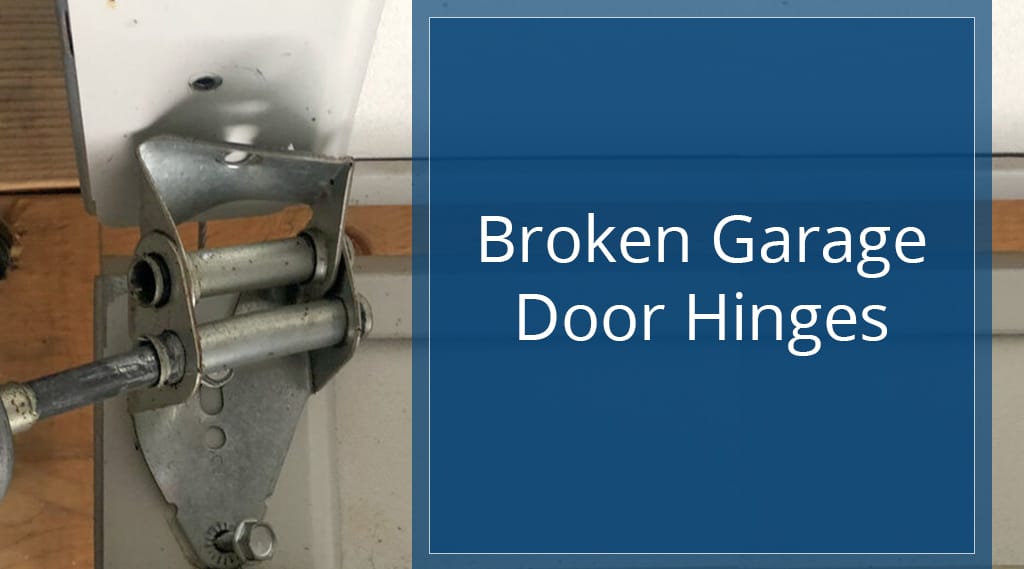
Broken Garage Door Hinges

When most people think of garage doors, they think of the doors, the opener, the remove, and maybe the tracks. Yes— garage door systems have lots of parts and there are more we haven’t named. In this post, we’re talking about hinges, specifically broken garage door hinges. Keep reading to learn more about types of garage door hinges, common hinge problems, and what to do when your garage door hinges are broken.
What are Garage Door Hinges?
Hinges are mechanisms that link two objects together, they’re used on all kinds of things.
Types of garage door hinges
Garage doors have center hinges and end hinges. Center hinges are located on the edge of the panels holding them together. End hinges are located at the end of the panels, these hinges also hold the rollers which slide along the garage door tracks. The bend in the hinge allows the panels to move smoothly along the rounded sections of the door track.
Standard hinges are made from galvanized steel and can be made in a variety of styles, shapes, and gauges. Hinges are typically distinguished by the steel gauge. The lower the gauge the thicker and stronger the hinge is. If you have a heavy door you’ll need a lower gauge hinge.
- 18-gauge hinges – usually work well on lightweight single-car garage doors
- 14-gauge hinges – are better for most residential garage doors
- 11-gauge hinges – are common for commercial garage doors
The cost of garage door hinges increases with strength.
5 Most Common Garage Door Hinge Problems
- Squeaky Hinge
- Stuck Hinge
- Loose Hinge
- Warped Hinge
- Broken Hinge
We recommend contacting a professional to identify and resolve any garage door problems. If you attempt to repair any garage door problems know that some repairs can be extremely dangerous. Before you begin any repair unplug or disconnect the power to your garage door opener.
How to Deal with a Squeaky Garage Door Hinge
Problem: The most common garage door hinge problem is a squeaky hinge. Noise from hinges comes from the friction caused by hinges that lack lubrication.
Solution: Lubricate the hinge where the two halves of the hinge pivot. Wipe off excess lubrication and repeat the process on all the hinges. For the end hinges repeat the same process and also apply lubrication to the barrel that holds the roller. Rotate the roller to spread the lube within the barrel. You’ll also want to spray lubricant on the cable post on the door’s bottom brackets and the roller attached to the bottom bracket.
Do not use oil or WD40 on your garage door. Choose a silicone-based spray instead.
How to Deal with a Stuck Garage Door Hinge
Problem: Not opening the door for an extended amount of time can cause the hinges to become stuck. It’s not so much the lack of use that’s a problem, the problem is the buildup of dust that gets into the hinge pin. A stuck or sticky hinge can prevent the door from opening and cause undue stress on the door opener.
Solution: Remove the pin to clean and lubricate the hinge. If you can’t remove the pin you may need to replace the entire hinge.
How to Deal with a Loose Garage Door Hinge
Problem: There are three reasons why hinges become loose. The first is expansion and contraction. Metal hinges react to changes in temperature by expanding and contracting, this movement can cause the hinges to become loose. The second is harsh movement in the door or a car bumping into the door while it’s in movement. The last reason is just a poor installation, for example, someone might replace the door panels but not fully tighten the hinges.
Solution: This is an easy one. Loose hinges just need to be tightened. If you try to tighten the hinges and they’re still loose then contact a pro.
How to Deal with a Warped Garage Door Hinge
Problem: Take a close look and see if your garage door hinges are warped. Hinges need to be straight to properly hold the door panels together and to move smoothly up the track. If your garage door is out of alignment or the jamb isn’t square, the whole door will be skewed. This will cause strain on all parts of the door including the hinges.
Solution: The door needs to be removed and the jamb needs to be repaired. If other parts of the door have been bent or damaged, you’ll want to replace the entire unit.
How to Deal with a Broken Garage Door Hinge
Problem: Garage door hinges can break when heavy objects impact the garage door panel or hinge directly. They can also break after years of neglect.
Solution: Replace the hinge. If the door was relatively new and the hinges appeared to be in good condition, they may have been too weak for your door. Replace the springs with a stronger gauge hinge.
Replacing Broken Garage Door Hinges
If the hinges on your garage door break earlier than expected replace them with stronger ones. The overall price of hinges isn’t expensive but stronger gauge hinges are more expensive than weaker gauges. Remember, the lower the gauge number the stronger it is.
We recommend working with a pro to diagnose your garage door problems. If you prefer to DIY the repair make sure you order the right hinges. Garage door hinges typically have a number stamped on the hinge to identify the type of hinge. Give these numbers to the hinge vendor so they can send you the right product.
When repairing garage door hinges, pull the emergency release cord so that no one moves the door while you are working and watch your fingers to avoid getting them trapped in the hinges.
Moving forward, remember to lubricate the pivot points. The lubrication helps them operate silently and resist corrosion.
Call Heritage Garage Door for Garage Door Repair
If you suspect that your garage door hinges need to be replaced contact our team to schedule an appointment. Our technicians can inspect your door and identify any additional problems that could be causing your hinges to wear out faster. We’ll find a solution to any garage door problem.
Heritage Garage Door operates in Southern California.


